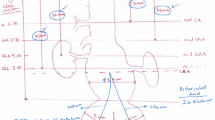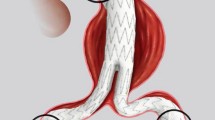Abstract
The proximal 4 mm of the Gore Excluder endoprosthesis are scalloped. Our purpose is to describe our initial experience of a novel technique, referred to as the “endowedge,” that takes advantage of this scalloped configuration in aneurysms with short proximal necks. The technique utilizes a balloon in the renal artery to aid alignment of a scallop and allow additional juxtarenal seal. A retrospective review of aneurysms treated with the endowedge technique at our institution was initiated. Renal balloons were placed via the brachial approach. Excluder endografts were deployed by flowering the first one or two rings, then advancing upward against the inflated balloon during completion of deployment. In patients with dumbbell-shaped morphology, an aortic cuff was deployed in the distal seal zone prior to the main body (kilt technique). Eight patients were identified, three of whom underwent an adjuvant kilt procedure. Average preoperative proximal neck length was 8.5 mm (range 6-12). Average additional juxtarenal seal was 2.3 mm. Mean follow-up was 5 months (range 2.5 weeks to 9 months). There were no type I endoleaks. There were two type II endoleaks. Average aneurysm size decreased from 6.0 to 5.5 cm. No aneurysm has enlarged or ruptured. We conclude that the endowedge technique allows additional juxtarenal seal during endograft placement. Our early results suggest that this technique may allow for safe treatment of aneurysms with short necks.




Similar content being viewed by others
References
Shumacher H, Eckstein HH, Kallinowski F, Allenberg JR. Morphometry and classification in abdominal aortic aneurysms: patient selection for endovascular and open surgery. J Endovasc Surg 1997;4:39-44
Minion DJ, Rodriguez C, Moore EM, Patterson DE, Endean ED. Technique of slow deployment of Gore Excluder endograft improves accuracy of placement. J Vasc Surg 2006;43:825-844
Anderson JL, Berce M, Hartley DE. Endoluminal aortic grafting with renal and superior mesenteric artery incorporation by graft fenestration. J Endovasc Ther 2001;8:3-15
Stanley BM, Semmens JB, Lawrence-Brown MM, Goodman MA, Hartley DE. Fenestration in endovascular grafts for aortic aneurysm repair: new horizons for preserving blood flow in branch vessels. J Endovasc Ther 2001;8:16-24
Greenberg RK, Haulon S, Lyden SP, et al. Endovascular management of juxtarenal aneurysms with fenestrated endovascular grafting. J Vasc Surg 2004;39:279-287
Verhoeven ELG, Prins TR, Tielliu IFJ, et al. Treatment of short-necked infrarenal aortic aneurysms with fenestrated stent-grafts: short-term results. Eur J Vasc Endovasc Surg 2004;27:477-483
Adams DJ, Berce M, Hartley DE, Anderson JL. Repair of juxtarenal para-anastomotic aortic aneurysms after previous open repair with fenestrated and branched endovascular stent grafts. J Vasc Surg 2005;42:997-1001
Greenberg RK, Haulon S, O’Neill, Lyden S, Ouriel K. Primary endovascular repair of juxtarenal aneurysms with fenestrated endovascular grafting. Eur J Vasc Endovasc Surg 2004;27:484-491
Haddad F, Greenberg RK, Walker E, et al. Fenestrated endovascular grafting: the renal side of the story. J Vasc Surg 2005;41:181-190
Katzen BT, MacLean AA, Katzman HE. Retrograde migration of an abdominal aortic aneurysm endograft leading to postoperative renal failure. J Vasc Surg 2005;42:784-787
Tonnessen BH, Sternbergh WC, Money SR. Mid- and long-term device migration after endovascular abdominal aneurysm repair: a comparison of AneuRx and Zenith endografts. J Vasc Surg 2005;42:392-400
Kibbe MR, Matsumura JS; Excluder Investigators. The Gore Excluder US multi-center trial: analysis of adverse events at 2 years. Semin Vasc Surg 2003;16:144-150
Vos AWF, Linsen MAM, Wisselink W, Rauwerda JA. Endovascular grafting of complex aortic aneurysms with a modular side branch stent-graft system in a porcine model. Eur J Vasc Endovasc Surg 2004;27:492-497
Anderson JL, Adam DJ, Berce M, Hartley DE. Repair of thoracoabdominal aortic aneurysms with fenestrated and branched endovascular stent grafts. J Vasc Surg 2005;42:600-607
Sternbergh WC, Carter G, York JW, Yoslevitz M, Money SR. Aortic neck angulation predicts adverse outcome with endovascular abdominal aortic aneurysm repair. J Vasc Surg 2002;35:482-486
Author information
Authors and Affiliations
Corresponding author
About this article
Cite this article
Minion, D.J., Yancey, A., Patterson, D.E. et al. The Endowedge and Kilt Techniques to Achieve Additional Juxtarenal Seal during Deployment of the Gore Excluder Endoprosthesis. Ann Vasc Surg 20, 472–477 (2006). https://doi.org/10.1007/s10016-006-9094-z
Received:
Revised:
Accepted:
Published:
Issue Date:
DOI: https://doi.org/10.1007/s10016-006-9094-z




